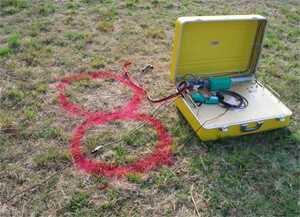Mining Contract: A Magnetic Communication System for Use in Mine Environments
| Contract # | 200-2007-22843 |
|---|---|
| Start Date | 9/11/2007 |
| End Date | 7/31/2009 |
| Research Concept | This contract will develop and demonstrate a two-way, through-the-earth communication system for mines that applies state-of-the-art communications technologies to overcome subterranean wireless communication challenges while meeting acceptable industrial safety standards. The system will feature transceivers on the surface and underground and use the earth's strata as the transmission medium. The underground transceiver will provide a dual-mode capability:
It is envisioned that transceivers might be located at fixed points and/or be integrated into a rescue chamber. During escape, miners could carry suitcase-sized units with them, but would need to stop to deploy an antenna to transmit. Should miners become trapped, the subsurface transceiver at the rescue chamber would also be able to operate in beacon mode where it would cycle through various transmission frequencies (3,000 to 5,000 Hz), sending a "sounding" signal at a predetermined time period. The transceiver would then listen between transmissions for a response. |
| Topic Area |
Contract Status & Impact
This contract is complete. To receive a copy of the final report, send a request to mining@cdc.gov.
Lockheed Martin developed a wireless, through-the-earth, prototype communication system based upon magnetic field generation and sensing. The system consists of surface and underground transceivers. The receiving antennas are comprised of three ferrite core windings arranged orthogonally and housed in a portable case. Software calculates the resultant vector signal. Various sized single and multiple turn air core antennas are used for transmission from underground to surface. Underground, the single loop of wire may be wound around a coal pillar. Voice and text messages are possible at signal transmission frequencies of 90, 330, and 3,200 Hz. The surface receiver features noise cancellation techniques. The goal of making the system portable while still being permissible was not achieved under this contract.
The system was tested at the NIOSH Pittsburgh Research Laboratory and at several coal mines in Southwestern Pennsylvania and Northern West Virginia. Signals were received at distances up to 5,100 feet in point-to-point underground tests. In underground to surface tests, the system was able to communicate successfully at vertical depths of 1,080 feet and up to 1,830 feet when the surface transceiver was moved away from the vertical axis.
Note: enhancements were made to this system under a subsequent contract 200-2009-32021 ("Magnetic Communication System").

See Also
- Communication Systems Research At Bruceton Safety Research Mine
- Development of a Visual Display and Control System
- Propagation of EM Signals in Underground Metal/Non-Metal Mines
- Propagation of EM Signals in Underground Mines
- Research and Development Contract for Coal Mine Communication System: Volume 3 - Theoretical Data Base
- Theoretical Noise and Propagation Models for Through-the-earth Communication
- Theory on the Propagation of UHF Radio Waves in Coal Mine Tunnels
- Through-The-Earth Wireless Real-Time Two-Way Voice Communications
- Ultra-Low Frequency Through-the-Earth Communication Technology
- Wireless Through-The-Earth Modeling and Support
- Page last reviewed: 7/19/2016
- Page last updated: 7/19/2016
- Content source: National Institute for Occupational Safety and Health, Mining Program


 ShareCompartir
ShareCompartir